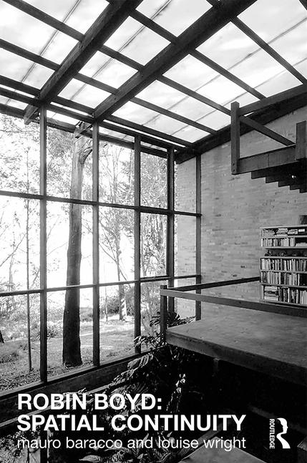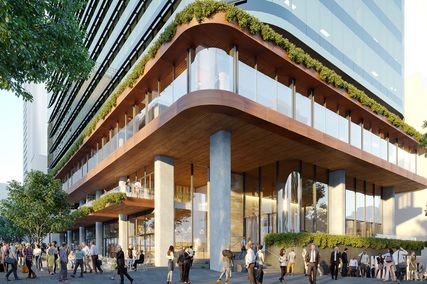
Robin Boyd: Spatial Continuity by Mauro Baracco and Louise Wright, published by Routledge.
A new book on Robin Boyd has arrived. Robin Boyd: Spatial Continuity is authored by Mauro Baracco and Louise Wright, both practising architects at Baracco and Wright. It is composed of two distinct parts: a concise, largely textual first part and a longer, predominantly visual second part that documents twenty-two projects by Boyd through photographs and drawings.
In the book’s introduction, Baracco and Wright explain that rather than placing “Boyd’s approach and works in relation to historical and cultural events that occurred throughout and parallel to his life and architectural career,” something that other Boyd scholars have done, in this book they seek to develop “an architectural theory beyond stylistic, aesthetic, cultural and social reasons of their own specific time.” To achieve this goal, Baracco and Wright pursue three lines of enquiry: they study Boyd’s thought and design approach, they construct a theory of his thought and design approach through a Heideggerian reading of his work and, finally, they outline how contemporary practitioners might learn from Boyd’s work by analysing examples of their own designs in relation to Boyd’s. Needless to say, Baracco and Wright set themselves a highly ambitious task. Pursuing these three lines of enquiry, Robin Boyd: Spatial Continuity combines different genres common to the study of architecture: theoretical treatise, didactic guide, promotional pamphlet (for Baracco and Wright) and, to a lesser extent, historical account. However, in oscillating between these genres, the book risks failing to fulfil the expectation of any particular reader – for instance, an architectural historian like me – who is likely more interested in one genre than the others.
In the first part of the book, which draws extensively on Heideggerian philosophy, Baracco and Wright argue that Boyd’s work deviates from mainstream international modernism and displays an “affinity with cultures and sensibilities that are in touch with the history, geography and culture of their places.” This point is well taken and, like Baracco and Wright’s suggestion that Boyd’s buildings were spatially ingenious and established a relevant dialogue with their context, it is widely accepted. Thus, when reading the first part of the book, a question emerges: Do we need Heideggerian theory to validate these observations? And, more broadly, does Boyd’s work need to be theorized in this way? What does drawing out parallels between Heidegger’s “critique of the objectifying nature of Western thought” and his philosophy to mitigate the modern overemphasis for rational representation through “meditative thinking” as a coexisting and parallel sensibility of “calculative thinking” on the one hand, and the “spatial continuity” recognized in Boyd’s work on the other, add to our knowledge of the architect’s thought and design approach? Particularly given that – to the authors’ admission – Boyd was “hardly involved with the field of philosophy, and there is no evidence that he read or discussed any work by the German philosopher.”
The strength of Robin Boyd: Spatial Continuity lies in the book’s second part. When leafing through this section, it becomes evident that Baracco and Wright have spent considerable time and energy carefully researching, documenting and retracing Boyd’s design works. They cover a broad selection of projects, some well known, other less so, and the result is impressive. As Baracco and Wright correctly and emphatically write: “Boyd’s projects have never been publicly shown with this level of comprehensiveness.” And yet … The publication format – a slightly enlarged A5 – does not do the material justice. The fineness and detail evident in Baracco and Wright’s drawings would have merited a larger, more elegantly designed book format, with more white space around the drawings, which are now all formulaically condensed onto one spread per project. Also, examining the plans in the book, I became increasingly frustrated with the lack of an indication of scale. I began to speculate that this omission was deliberate; an attempt to counteract my Western predilection for “rational representation” in favour of “a state of wondering,” as promoted by Heidegger. I only discovered much later that the scale of the drawings is indeed recorded in the book, in the figures section at the front – well away from the actual drawings. It is likely that larger drawings, with a visual indication of the scale on the page, would have increased the book’s visual appeal, as well as its utility for those interested in an in-depth, plan-based study of Robin Boyd’s work, in all its facets.
As it stands, Robin Boyd: Spatial Continuity offers a valuable resource for anyone interested in studying the relation between spaces in Boyd’s architectural work. Carefully documenting the layouts of twenty-two projects designed by the talented Australian architect, the book inevitably highlights important lessons for those pursuing architectural design today – particularly those concerned with a “sense of” and “care for” place. Would I recommend Robin Boyd: Spatial Continuity to those looking for a refreshing theoretical appraisal of Boyd’s thought and design approach? Probably not.
Robin Boyd: Spatial Continuity by Mauro Baracco and Louise Wright can be purchased here.














